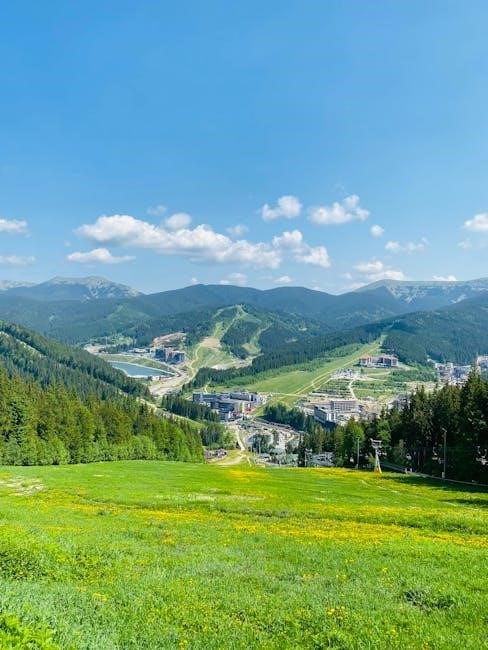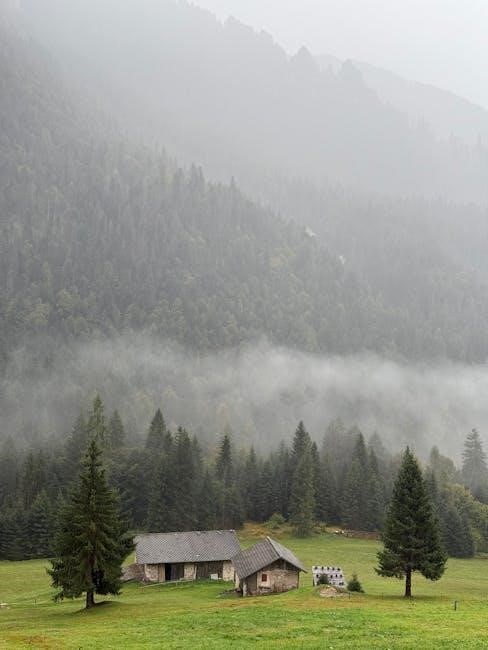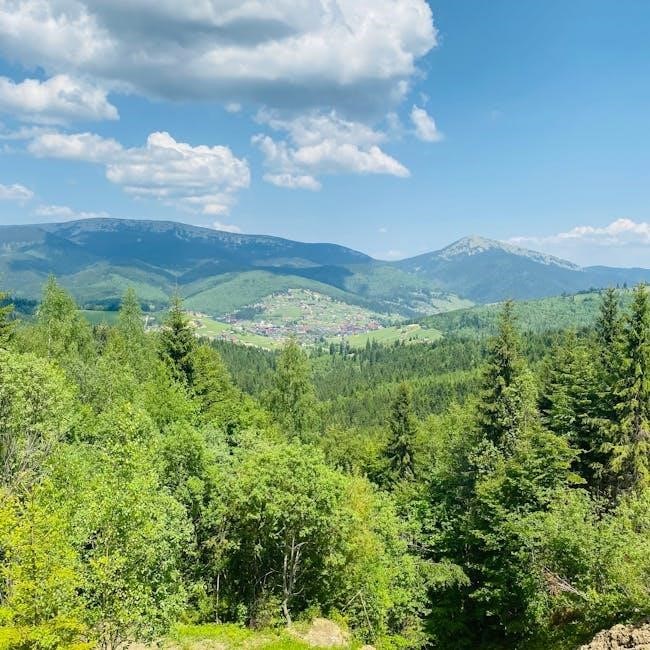The Indus Valley Civilization, thriving from 3300-1300 BCE, was a Bronze Age society known for its urban centers, advanced infrastructure, and sophisticated socio-economic framework in South Asia;
Overview of the Civilization
The Indus Valley Civilization, flourishing from 3300-1300 BCE, was a Bronze Age society in South Asia, centered along the Indus River. It featured well-planned cities like Harappa and Mohenjo-Daro, with advanced infrastructure and a sophisticated socio-economic framework. The civilization is known for its urbanization, trade networks, and cultural achievements, including a unique writing system. Its economy relied on agriculture and crafts, with a strong emphasis on resource management and social organization.
Historical Significance
The Indus Valley Civilization holds immense historical significance as one of the earliest urban cultures worldwide. It laid the foundation for South Asia’s cultural and technological advancements, influencing later civilizations. Its sophisticated urban planning, trade networks, and unique script highlight its prominence alongside ancient Mesopotamia and Egypt, showcasing human innovation and societal complexity in the Bronze Age.
Geographical Extent
The Indus Valley Civilization spanned across the northwestern regions of South Asia, covering modern-day northeast Afghanistan, Pakistan, and northwest India. It flourished along the Indus River and its tributaries, extending from the Himalayan foothills to the Arabian Sea. This vast region, known as Sapta-Sindhava (Land of Seven Rivers), supported numerous settlements, with key sites like Harappa and Mohenjo-Daro emerging as urban centers.
Origins and Phases of the Indus Valley Civilization
The Indus Valley Civilization emerged around 3300 BCE, evolving through phases: Early Harappan (3300-2600 BCE), Mature Harappan (2600-1900 BCE), and Late Harappan (1900-1300 BCE).
Early Harappan Phase (3300-2600 BCE)
The Early Harappan Phase marked the transition from Neolithic traditions to a more complex society. Emerging around 3300 BCE, this period saw the growth of small villages and the development of agriculture, with communities relying on the fertile plains of the Indus Valley. Trade networks began to expand, both locally and with neighboring regions. This phase laid the groundwork for urbanization and the emergence of a writing system, reflecting early cultural and technological advancements.
Mature Harappan Phase (2600-1900 BCE)
The Mature Harappan Phase represents the zenith of the Indus Valley Civilization, characterized by advanced urban planning and infrastructure. Cities like Harappa and Mohenjo-Daro showcased standardized brick construction, intricate drainage systems, and a clear social hierarchy. Trade networks extended to Mesopotamia, fostering economic prosperity. This period also saw the development of a writing system, though it remains undeciphered. The civilization’s sophistication in craftsmanship, metallurgy, and governance underscored its prominence during this era.
Decline and Late Harappan Phase (1900-1300 BCE)
The Late Harappan Phase marked the decline of the Indus Valley Civilization, with cities showing reduced urban planning and infrastructure. Trade networks weakened, and craftsmanship declined. Environmental factors, such as climate change and river shifts, may have contributed to this decline. Populations dispersed, leading to smaller settlements. This period saw the eventual fading of the civilization’s distinct cultural and technological advancements, leaving behind a legacy of mystery and unanswered questions about its ultimate fate.
Urban Planning and Architecture
The Indus Valley Civilization showcased advanced urban planning with well-planned cities, standardized brick sizes, and sophisticated drainage systems, reflecting a highly organized architectural approach.
Layout of Cities like Harappa and Mohenjo-Daro
The cities of Harappa and Mohenjo-Daro were meticulously planned with a grid layout, featuring separate areas for administrative, religious, and residential activities. The citadel, or elevated area, housed public buildings, while the lower city included residential quarters and marketplaces. Streets were laid out in a grid system, with houses built in blocks. This organized structure highlights the advanced urban planning and engineering skills of the Indus Valley people.
Advanced Drainage and Water Management Systems
The Indus Valley Civilization is renowned for its sophisticated drainage and water management systems. Cities like Harappa and Mohenjo-Daro featured intricate networks of brick-lined drains, sewage systems, and public baths. These systems ensured efficient waste removal and water supply, reflecting advanced engineering and urban planning. The use of sloped streets and well-constructed drainage channels further highlights their innovative approach to maintaining hygiene and public health in densely populated urban centers.
Architectural Features of Buildings
The Indus Valley Civilization is distinguished by its well-planned buildings constructed with kiln-fired bricks, showcasing advanced architectural skills. Structures like the Great Bath at Mohenjo-Daro highlight sophisticated design. Homes and public buildings featured courtyards, multiple stories, and standardized brick sizes, reflecting a high degree of planning and engineering expertise. These architectural features emphasize the civilization’s emphasis on functionality, durability, and aesthetic appeal in their built environment.
Economy and Trade
The Indus Valley Civilization had a robust economy with trade networks extending to Mesopotamia, utilizing standardized weights and seals, showcasing advanced economic and technological prowess compared to contemporaries.
Agricultural Practices
The Indus Valley Civilization relied heavily on agriculture, cultivating crops like wheat, barley, and cotton. They domesticated animals such as cattle and sheep, indicating a strong pastoral economy. Advanced irrigation techniques were used, leveraging the Indus River’s annual floods. Tools made of copper and stone highlight their technological prowess. This agricultural surplus supported urbanization and trade networks, showcasing their sophisticated economic framework.
Crafts and Industries
The Indus Valley Civilization excelled in craftsmanship, producing intricate pottery, seals, and jewelry. Skilled artisans crafted pottery using wheel techniques, while seals featured intricate carvings. Metallurgy was advanced, with bronze tools and ornaments. Textiles, particularly cotton, were significant, with evidence of weaving and dyeing. Crafts industries supported trade networks, showcasing their technological and artistic expertise. These innovations underscored their sophisticated economic and cultural advancements.
Trade Networks with Mesopotamia and Other Regions
The Indus Valley Civilization maintained extensive trade networks with Mesopotamia and other regions. Goods like cotton, metals, pottery, and seals were exchanged. Trade routes connected the Indus Valley with Afghanistan, Gujarat, and the Persian Gulf. Maritime trade linked it to Mesopotamia, while overland routes extended to Central Asia. These networks facilitated economic prosperity and cultural exchange, highlighting the civilization’s integration into a broader ancient global economy.

Art and Culture
The Indus Valley Civilization showcased a rich cultural tapestry through its undeciphered script, intricate artifacts, and symbolic representations, reflecting advanced artistic and religious practices;
Indus Valley Script and Its Significance
The Indus Valley script remains one of archaeology’s greatest mysteries, functioning primarily as a mnemonic device for rituals and ceremonies. Comprising pictographic symbols, it encoded proto-mantras and ceremonial protocols, blending imagery and abstraction. Despite remaining undeciphered, its sophistication highlights the civilization’s advanced communication systems. Its study offers insights into early writing systems and cultural practices, linking it to later South Asian linguistic traditions.
Religious and Spiritual Practices
The Indus Valley Civilization likely practiced nature-oriented worship, with rituals centered around fertility, water, and natural phenomena. The presence of seals with symbolic motifs, such as the Pashupati seal, suggests a form of proto-Hindu worship. Rituals may have involved ceremonial bathing and offerings, reflecting a deep connection to the environment. Artifacts indicate a reverence for a mother goddess and tree symbols, highlighting spiritual practices intertwined with daily life and natural cycles.
Artifacts and Symbolism
Artifacts from the Indus Valley Civilization reveal a rich cultural landscape. Seals featuring animal motifs, like the Pashupati seal, suggest symbolic and ritualistic significance. Pottery, jewelry, and sculptures showcase advanced craftsmanship. These artifacts often depict religious and natural themes, indicating a society deeply connected to spirituality and the environment. Their intricate designs and standardized production highlight a sophisticated understanding of aesthetics and symbolism, offering insights into the civilization’s values and beliefs.

Technology and Scientific Achievements
The Indus Valley Civilization showcased technological prowess through advanced metallurgy, engineering marvels, and a sophisticated understanding of mathematics and weights, reflecting remarkable scientific achievements.
Metallurgy and Tool Production
The Indus Valley Civilization demonstrated advanced metallurgical skills, crafting tools from copper, bronze, and gold. Artisans produced axes, knives, and drills, showcasing precision engineering. Evidence of metal workshops highlights their technical expertise in alloying and casting. These tools were essential for agriculture, construction, and daily life, reflecting a highly skilled and organized society. Their sophisticated metallurgy underscores the civilization’s technological advancement and innovation.
Engineering Marvels
The Indus Valley Civilization is renowned for its engineering marvels, including sophisticated urban planning and advanced water management systems. The grid layout of cities like Harappa and Mohenjo-Daro, with wide roads and drainage networks, reflects remarkable town planning. Public structures like the Great Bath and granaries demonstrate architectural ingenuity. These engineering feats highlight the civilization’s expertise in construction and urban design, showcasing a high level of technological sophistication for their time;
Mathematical and Astronomical Knowledge
The Indus Valley Civilization demonstrated advanced mathematical and astronomical knowledge through their precise urban layouts and standardized weights and measures. Their seals and artifacts reveal a system of mathematics based on decimal and binary principles. Astronomical observations likely influenced their agricultural practices and religious rituals, indicating a sophisticated understanding of time and space. This knowledge underscores their cultural and technological advancements in ancient South Asia.

Social Structure and Daily Life
The Indus Valley Civilization was highly urbanized, with a structured social hierarchy and community-oriented daily life, reflecting advanced organization and cultural practices in ancient cities;
Social Hierarchy
The Indus Valley Civilization was one of the first urban societies, with a well-defined social hierarchy. The ruling class likely consisted of elites residing in grand structures, while merchants, artisans, and laborers formed the backbone of the economy. The presence of seals and artifacts suggests a sophisticated administrative system, possibly indicating religious or ceremonial leaders. This structured society highlights their advanced organization and cultural complexity, reflecting a thriving urban culture in ancient South Asia.
Family and Community Life
Family and community life in the Indus Valley Civilization were central to its social fabric. Close-knit family structures likely existed, with women managing households and children. Public spaces, such as baths and community centers, reflect strong communal bonds. Artisans and merchants played vital roles, contributing to the economy and cultural exchange. This well-organized society emphasized collective well-being, showcasing a harmonious blend of individual family life and community interaction, fostering a vibrant urban culture.
Clothing and Personal Adornments
The Indus Valley people likely wore garments made from cotton, wool, and linen, as evidenced by terracotta figurines and seals. Personal adornments included beads, necklaces, bangles, and earrings, crafted from materials like carnelian, lapis lazuli, and gold. Their attire and jewelry reflected social status and cultural identity, showcasing a sophisticated sense of style and craftsmanship, with trade networks supplying diverse materials for these ornaments.

Environmental Interaction
The Indus Valley Civilization thrived in the fertile region of the seven rivers, supporting agriculture and enabling advanced resource management practices for sustainability.
Geography of the Indus Valley
The Indus Valley Civilization flourished in the fertile plains of the Indus River and its tributaries, spanning modern-day Pakistan, northwest India, and parts of Afghanistan. The region, known as Sapta-Sindhava, was characterized by vast riverine landscapes and fertile soil, supported by the Himalayan mountain ranges and seasonal monsoon rains. This geographical setting provided ideal conditions for agriculture and urban development, making it a cradle for one of the world’s earliest urban societies. The Indus River, with its annual floods, ensured rich silt deposits, fostering a prosperous agricultural base that sustained the civilization’s growth and cultural advancements. The strategic location also facilitated trade connections with neighboring regions, contributing to the civilization’s economic prosperity and cultural exchange. The interplay of rivers, climate, and terrain shaped the unique environmental and cultural landscape of the Indus Valley Civilization, enabling it to thrive for millennia. The region’s diverse ecosystems, from river valleys to arid zones, supported a wide range of flora and fauna, further enriching the civilization’s ecological interactions. This intricate relationship between geography and human settlement remains a cornerstone of understanding the Indus Valley Civilization’s rise and enduring legacy.
Impact of Climate Change
Climate change significantly impacted the Indus Valley Civilization, with rising temperatures and altered rainfall patterns affecting agricultural productivity. Shifts in monsoon dynamics and river courses disrupted the fertile silt deposits essential for farming. These environmental challenges likely contributed to the civilization’s decline, as resources dwindled and urban centers faced unsustainable conditions. The civilization’s resilience was tested, highlighting the interplay between climate and societal stability in ancient times. Adaptation strategies were crucial for survival, but long-term sustainability remained elusive.
Resource Management Practices
The Indus Valley Civilization demonstrated advanced resource management practices, leveraging the fertile Indus River basin for agriculture and urban planning. Efficient irrigation systems and water conservation techniques supported crop cultivation, while strategic land use ensured sustainable resource distribution. The civilization’s emphasis on organized waste management and infrastructure highlighted a sophisticated understanding of environmental stewardship, enabling thriving cities and a stable economy. These practices underscored their ability to harmonize human needs with natural resources effectively.

Decline and Legacy
The Indus Valley Civilization declined due to environmental changes and invasions, leaving a lasting legacy in urban planning, trade, and cultural influences on later civilizations.
Theories on the Decline of the Civilization
The decline of the Indus Valley Civilization is attributed to multiple factors, including climate change, droughts, and shifting river courses. Environmental degradation, such as deforestation and soil salinization, likely disrupted agriculture. Invasions by nomadic tribes and resource depletion further exacerbated the collapse. These theories suggest a combination of natural and human-induced factors leading to the civilization’s gradual decline by 1300 BCE.
Cultural and Technological Legacy
The Indus Valley Civilization left a profound cultural and technological legacy, influencing future societies. Its advanced urban planning, metallurgy, and craftsmanship set benchmarks for later civilizations. The use of standardized weights, seals, and pottery highlights their technological prowess. Cultural practices, such as artisans’ expertise in jewelry-making and trade networks, fostered exchange and innovation, shaping the socio-economic landscape of the region for centuries to come.
Influence on Later Civilizations
The Indus Valley Civilization’s innovations in urban planning, trade, and technology significantly influenced later civilizations. Its advanced drainage systems and metallurgy inspired neighboring cultures, while its extensive trade networks facilitated cultural exchange. The civilization’s emphasis on craftsmanship and standardized practices set precedents for future societies, ensuring its legacy endured in the development of subsequent civilizations across South Asia and beyond.
Sources and Archaeological Discoveries
The discovery of Mohenjo-Daro and Harappa in the 1920s unveiled the Indus Valley Civilization. Excavations revealed seals, pottery, and artifacts, providing insights into their culture and daily life.
Key Excavation Sites
The primary excavation sites of the Indus Valley Civilization include Harappa and Mohenjo-Daro in modern-day Pakistan. These sites, discovered in the 1920s, revealed well-planned cities with advanced infrastructure. Excavations uncovered streets, drainage systems, and buildings, showcasing urban sophistication. Other significant settlements like Dholavira in Gujarat and Rakhigarhi in Haryana highlight the civilization’s vast geographical spread, providing valuable insights into its culture and daily life.
Importance of Seals and Artifacts
Seals and artifacts from the Indus Valley Civilization are crucial for understanding its culture. These seals, often depicting animals and symbols, feature the undeciphered Indus script, suggesting their use in administration or ritual. Artifacts like pottery, jewelry, and tools reveal advanced craftsmanship and societal sophistication. They provide insights into trade, religion, and daily life, serving as tangible evidence of the civilization’s achievements and legacy, despite the script remaining one of history’s greatest mysteries.
Modern Archaeological Techniques
Modern archaeological techniques like ground-penetrating radar, drones, and geochemical analysis are revolutionizing Indus Valley research. These tools help locate buried sites, map vast areas, and analyze materials without damage. 3D scanning preserves artifacts digitally, aiding in global collaboration and education. Such advancements provide deeper insights into the civilization’s urban planning, trade networks, and daily life, helping researchers uncover its secrets more efficiently than ever before.
Contemporary Relevance and Studies
The study of the Indus Valley Civilization remains relevant today, with ongoing research, educational resources, and tourism fostering a deeper connection to its history and legacy.
Current Research and Debates
Current research on the Indus Valley Civilization focuses on deciphering its script, understanding its decline, and exploring its technological advancements. Scholars debate whether climate change or external invasions caused its decline. New discoveries, such as geospatial mapping of settlements, shed light on urban planning. Researchers also explore cultural exchanges with Mesopotamia and the significance of seals and artifacts. These studies continue to unravel the mysteries of this ancient civilization, fostering ongoing academic discourse and public interest.
Educational Resources and Outreach
Educational resources on the Indus Valley Civilization include textbooks, online courses, and interactive tools for students. Video lectures, such as those by Mr. Salah Sabri, provide accessible learning. Outreach programs, like museum exhibits and cultural festivals, engage communities. Digital platforms offer historical insights, while workshops and seminars foster academic dialogue. These resources aim to educate and inspire a broader audience about this ancient civilization’s legacy and significance in global history.
Cultural Revival and Tourism

Cultural revival initiatives highlight the Indus Valley Civilization’s heritage through museums, festivals, and heritage sites. Tourism promotes exploration of ancient cities like Harappa and Mohenjo-Daro, attracting global interest. Local communities engage in preserving traditions, while digital media showcases artifacts and history. These efforts foster cultural pride and economic growth, connecting modern audiences to the civilization’s enduring legacy and historical significance.
The Indus Valley Civilization stands as a testament to early urban culture, renowned for its advanced planning and infrastructure. Flourishing from 3300-1300 BCE, with a mature phase between 2600-1900 BCE, it left a lasting legacy. Its contributions to culture, technology, and trade continue to inspire study and admiration. The civilization’s mysterious script and enduring influence highlight its significance, making it a subject of enduring fascination.
